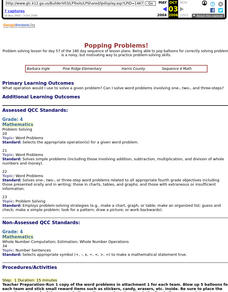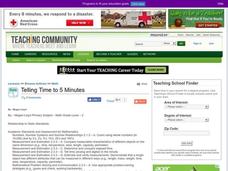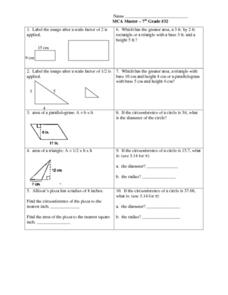Curated OER
Hoping Backward to Solve Problems
Young scholars use number lines to compare differences. In this math lesson, students use a number line to solve problems. Young scholars predict differences and answer puzzles using subtraction.
Curated OER
Working Backwards
Young scholars explore the concept that to solve some problems, they may need to undo the key actions in the problem. This strategy is called working backwards asking the appropriate questions.
Curated OER
Word Clue and All About Me Problem Solving
Fifth graders practice solving word problems using highlighted strategies. In this word problem instructional activity, 5th graders brainstorm and use words as clues that indicate the math operations that will be used to solve...
Curated OER
Working Backwards
Sixth graders make up their own math problems. There is only one restriction. That is, the answer has to be the one you are going to give them in a sealed envelope. The problems that they make up can be anything they like. Let Students...
Curated OER
Problem Solving
Fifth graders read and write equations. In this equation writing lesson, 5th graders use real life scenarios to write equations. Students use manipulatives, draw pictures and make tables to understand how to write equations. Students...
Arizona Department of Education
Introduction to Integers
Welcome to the backward world of negative numbers. This introductory lesson teaches young mathematicians that negative numbers are simply the opposite of positive numbers as they use number lines to plot and compare...
Curated OER
Popping Problems!
Turn your math lesson into a carnival game with this fun, outdoor activity. After reviewing the concept your class will be practicing briefly, split your class up into teams and head outdoors. These teams work to solve math questions and...
EngageNY
Percent Increase and Decrease
Increase the percent of pupils that are fluent in solving change problems with an activity that asks class members to look at problems that involve either increases or decreases and to express the change in terms of the percent of...
Illustrative Mathematics
Shirt Sale
Everyone loves a good deal, and your mathematician's job is to calculate the original price when given the discount. A different type of problem than the traditional "find the percent change" has your learners working backwards to...
Curated OER
Use Guess and Check to Solve Math Problems
In this problem solving worksheet, students read about using the guess and check strategy for solving math word problems. They use the strategy to solve 8 problems. They read about the working backwards and using visuals as problem...
Curated OER
Fraction Puzzle Problems
Fifth graders design a fraction word problem PowerPoint presentation. In small groups they complete a storyboard graphic organizer for their word problem, evaluate another group's word problem, and create a PowerPoint presentation of...
Curated OER
Life is Full of Problems
Pupils use the problem solving strategy of guess and check to investigate math word problems. They determine which problem solving strategy or strategies would work best in problem situations.
Curated OER
Problem Solving: Steps and Strategies
Students explore the concept of problem solving strategies. In this problem solving strategies lesson, students discuss methods for solving problems such as re-reading a problem, stating the facts, drawing a picture and so on. Students...
Curated OER
Simple Strategies
Here is a fabulous lesson plan on problem solving strategies for your charges. In it, learners are presented with many excellent techniques they can use when faced with a multi-step math word problem. Some terrific blackline masters are...
Curated OER
Not So Snappy 9 Word Problems
In this math worksheet, students practice solving word problems which require them to make a list or work backwards to find the solution. Students read and solve 5 word problems.
Curated OER
Using Polya's 4 Steps to Problem Solving
Ninth graders solve problems using Polya's 4 steps to problem solving.
Curated OER
Telling Time to 5 Minutes
In this second grade lesson your class will practice telling time. The goal is to tell time to five minutes using an analog clock. Your young students count by 5 minute intervals and discuss elapsed time.
Curated OER
Investigation - What's the Number?: Division
Seventh graders explore number sentences using a variety of strategies making each equation a true sentence. Students examine strategies such as patterns, trial and error, working backwards, and related problems. In groups, 7th graders...
Curated OER
Geometry: Area, Scale Factor, Circumference
In this geometry worksheet, students solve 10 problems regarding area, scale factors, and circumference. Students, in 3 of the problems, are given the circumference and asked to work backwards to find missing information.
Curated OER
THE BACKWARD DESIGN PROCESS
Learners explain the practical uses of robots. They interpret possible careers in robotics, apply the safety guidelines of robots, and develop a perspective of the use of robots. They empathize with the cultural issues of robots in work...
Curated OER
Problem-Solving Strategies in Word Problems
Students examine how to determine which strategy to use to solve word problems. In this word problem strategy activity, students listen to a lecture on the process of using different strategies to solve math problems. They look at guess...
Curated OER
Solve for Scale Factors Using Proportions
Eighth graders solve problems using proportions with scaled drawings. They work with maps and blue-prints discussing scales and plans and examine different polygons and figure out the scale factors or proportions they have been changed by.
Curated OER
Proving Quadrilateral Properties
Working backwards can sometimes help you see a path to solving a problem. In this chapter, properites of quadrilaterials are proven by looking at flowcharts and working the probem backwards. Worked through examples are given, along with...
Curated OER
Number Sentences
Fifth graders become familiar with problem solving strategies of guess and check and working backwards. They demonstrate the basic concepts of addition, subtraction, multiplication, and division using a math sentence.























